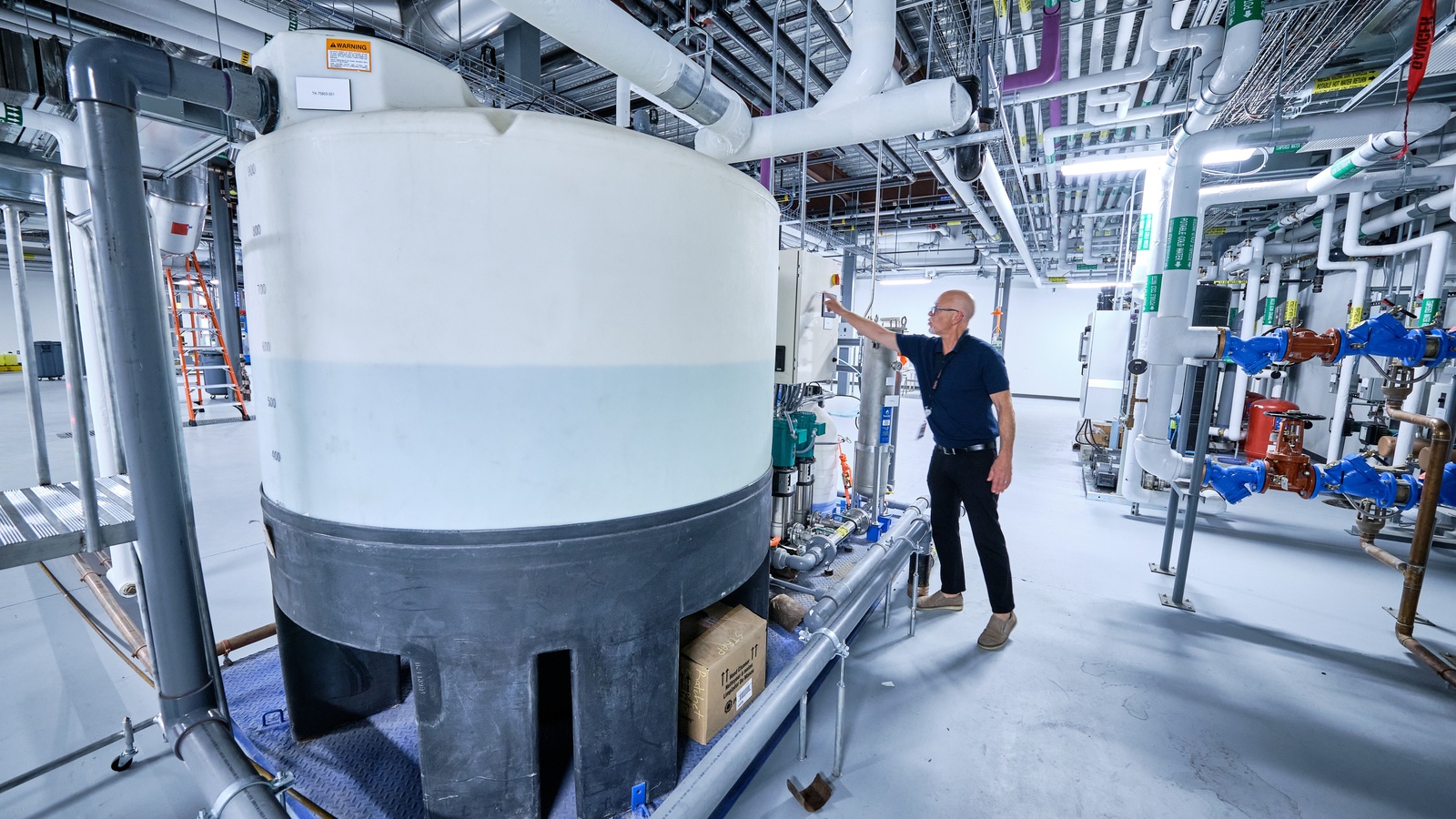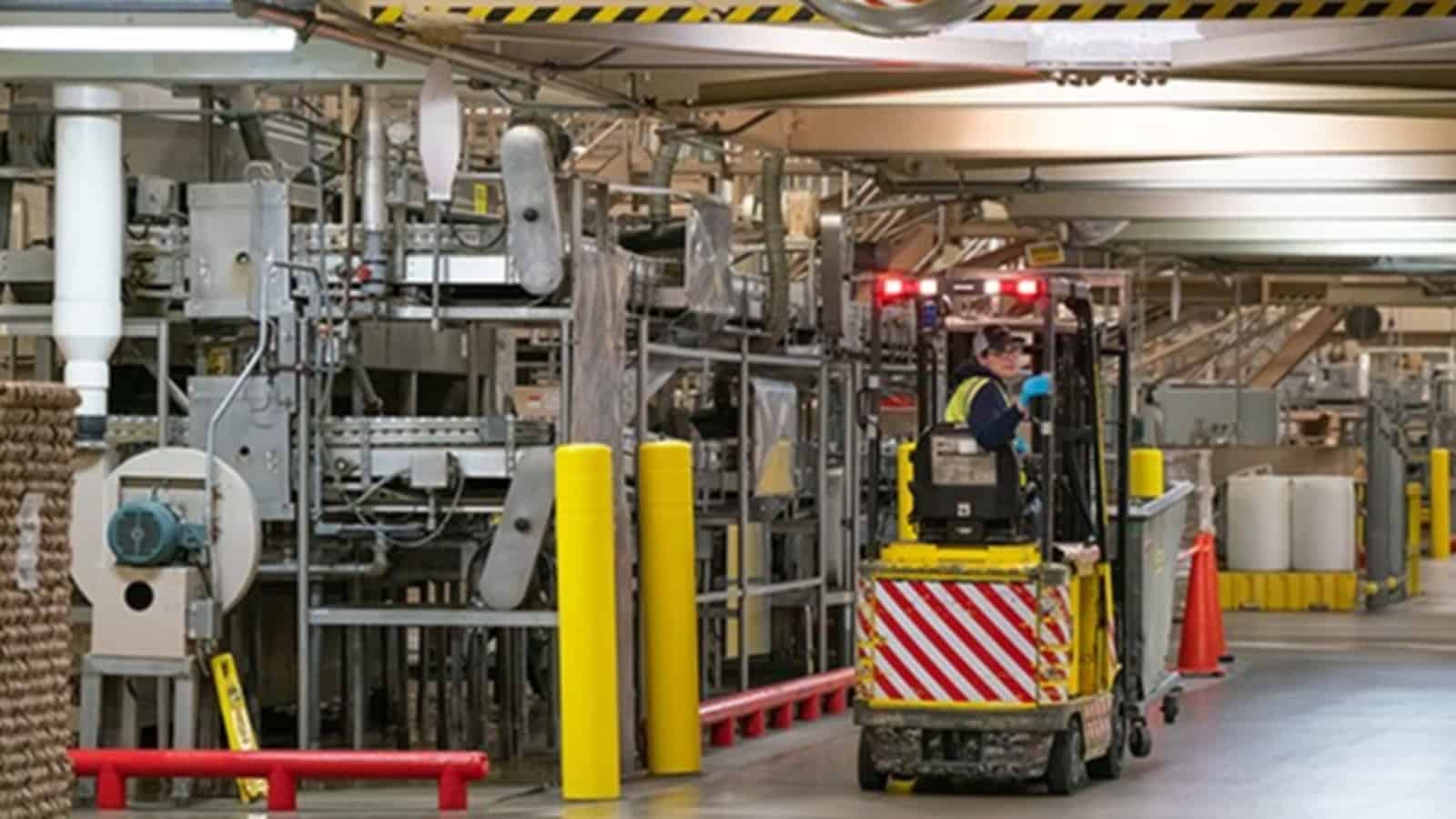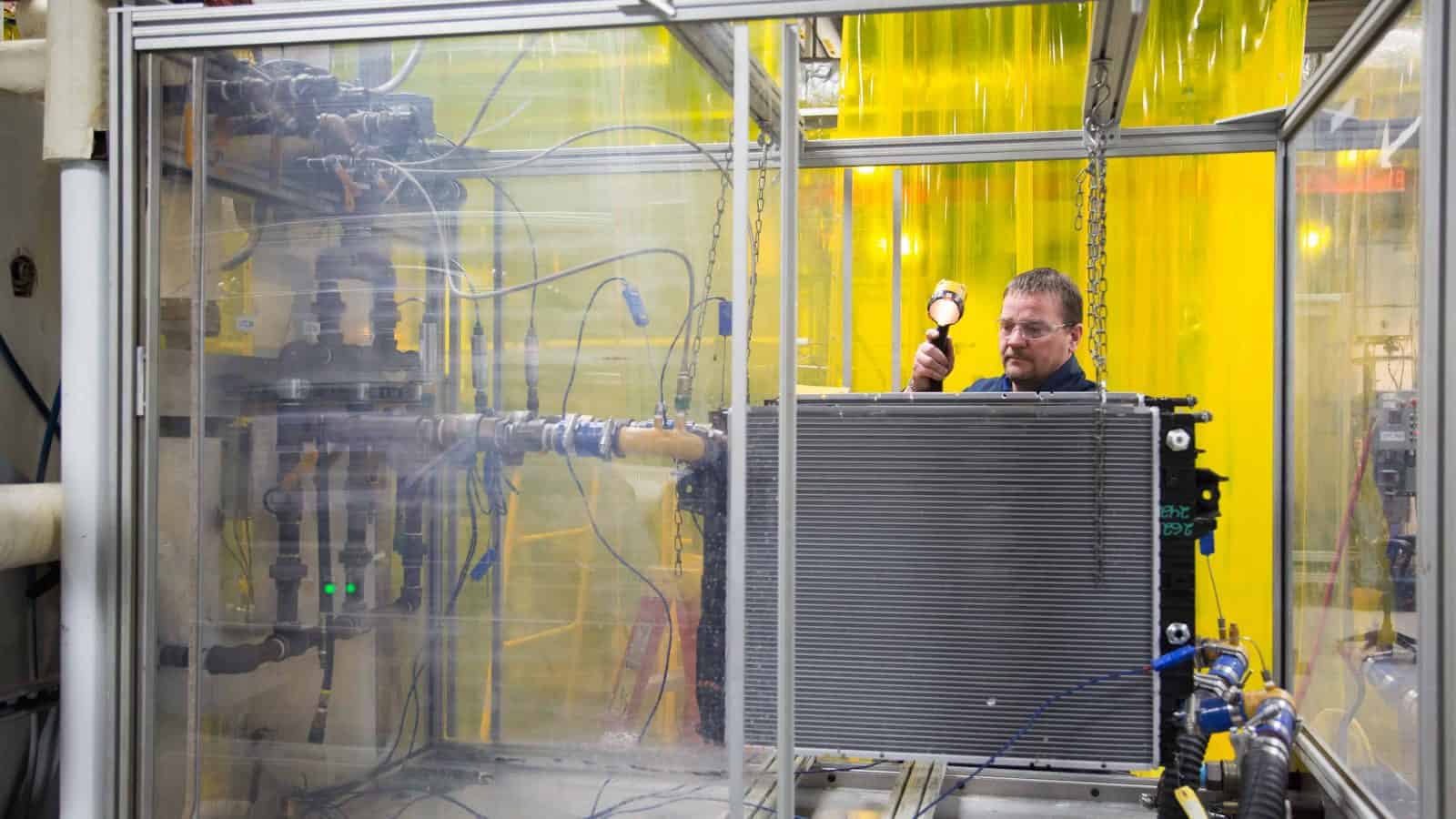Senate Moves to Onshore Uranium Production

The Senate voted overwhelmingly to create a Nuclear Fuel Security Program aimed at bolstering U.S. supplies of enriched uranium, according to the Senate Committee on Energy and Natural Resources.
What’s going on: On Thursday, the Senate voted 96–3 to include Sen. John Barrasso’s (R-WY) Nuclear Fuel Security Act amendment in next fiscal year’s National Defense Authorization Act.
- The “[a]mendment … directs the Department of Energy (DOE) to prioritize activities to increase domestic production of low-enriched uranium (LEU) for existing reactors and accelerate efforts to ensure the availability of high-assay, low-enriched uranium (HALEU) for advanced reactors,” according to the committee press release.
- The bipartisan measure was introduced in February by Sens. Barrasso, Joe Manchin (D-WV) and Jim Risch (R-ID); in May, it was passed by voice vote.
Why it’s important: Most of the advanced nuclear reactor concepts set to come online in the next few years require HALEU—and Russia is the only viable commercial supplier, according to E&E News’ ENERGYWIRE (subscription).
- “Russia now supplies 24% of our enriched uranium imports,” Sen. Barrasso said before the committee on Thursday. “We spend nearly $1 billion each year on Russian uranium. Russia uses these revenues to fund its invasion of Ukraine. Here in America, we have the resources to fuel our own reactors. My amendment authorizes the Department of Energy to take the steps necessary to expand U.S. nuclear fuel production.”
The NAM’s role: The NAM has strongly advocated for the development of nuclear energy, which will play a critical role in U.S. energy security and decarbonization efforts.
- As NAM President and CEO Jay Timmons told Congress in June, “Nuclear energy can help the U.S. generate more clean energy, stabilize our grids and improve our energy security.”
A Renewables Industry Faces Headwinds

The Biden administration is hoping offshore wind farms will provide enough power for 10 million homes by the end of this decade—but energy companies are having trouble financing the projects, according to POLITICO.
What’s going on: “Up and down the Northeast—the center of the burgeoning [wind power] industry … energy companies have struggled to finance their projects, going hat in hand to governors and utility regulators asking for more money so they can start building the turbines they have already promised to deliver.”
- Many consumers concerned about already increasing energy costs are wary of more taxpayer funds going to such projects—but without additional government funds, many current wind projects may not get built at all.
The big picture: “Offshore wind takes a combination of state and federal green lights to work. … Federal, state and local permits all have to be secured to make the projects a reality, which gives opponents numerous chances to stall or kill projects.”
- Thus far, federal regulators have approved just three offshore wind projects nationally—underlining the dire need for permitting reform, which the NAM has long called for.
- Meanwhile, “Only seven offshore wind turbines are producing power and just two of the larger projects are truly under construction,” according to POLITICO.
States struggle: Wind-power projects in New Jersey and Massachusetts are facing financial hurdles, with the costs for one project increasing 30% since approval two years ago.
- Geopolitics and the larger economy have weighed on U.S. wind power, too. “Inflation is up—the cost of steel has soared since the pandemic—interest rates are higher and the labor market is tighter. Paradoxically, the war in Ukraine made clear how important domestic energy is while at the same time driving up the costs to produce it.”
The NAM says: “Manufacturers depend on access to reliable and affordable energy, which is why the NAM strongly supports reforms that would foster transparent, streamlined and timely federal regulatory processes,” said NAM Vice President of Domestic Economic Policy Brandon Farris.
- “Our antiquated permitting system is driving up construction costs and has the potential to reduce energy security. The NAM will continue to fight for common-sense permitting reforms that expedite the development of many energy projects, including renewables.”
Incandescent-Bulb Rules to Be Fully Enforced

Following years of regulatory disputes, the incandescent lightbulb will be almost completely phased out starting this month, according to E&E News’ ENERGYWIRE (subscription).
What’s going on: “Along with prohibiting the manufacture, import and retail sales of most incandescent bulbs, [Department of Energy] rules finalized last year authorize DOE to slap penalties of $542 on companies per each violation. That could mean millions of dollars in fines for large incandescent orders.”
- DOE says the move will cut greenhouse gas emissions and lower consumers’ utility bills.
- While there is not an explicit ban on incandescent bulbs, most of them are unable to meet the efficiency requirements that were set by Congress in 2007 and will now go into full enforcement.
What it could mean: “Industry representatives say the sweep of regulations on various appliances will spike upfront costs for consumers in the market for appliances,” ENERGYWIRE reports. “Republican lawmakers on Capitol Hill argue the Biden administration is waging a back-door campaign to ban gas stoves and other appliances.”
Stricter Water Heater Standards Would Cost Manufacturers

The Department of Energy released a draft proposal late last week that would impose stricter efficiency standards on water heaters—and increase costs for manufacturers, E&E News’ ENERGYWIRE (subscription) and The Washington Examiner report.
What’s going on: On Friday night, the DOE released a 425-page plan “to mandate energy efficiency levels for new consumer water heaters, which the department defines as appliances in homes and small businesses that use ‘oil, gas or electricity to heat potable water for use outside the heater upon demand,’” according to ENERGYWIRE.
- The Biden administration says the move—which would go into effect in 2029 if approved in its current iteration—would cut carbon dioxide emissions and reduce energy use by residential water heaters, saving consumers money.
- The draft rule arrives just months after the DOE released a proposal to phase out approximately half of the gas-powered stoves on the market. The House recently approved two measures to stop “gas stove rulemaking from DOE and the Consumer Product Safety Commission,” according to ENERGYWIRE.
What it would mean: The water heater rule would force manufacturers to use heat pump technology to produce electric water heaters and condensing technology to make gas-fired water heaters—and it would spike production costs in the process, according to the Examiner.
- “The [DOE] draft outlines the potential effect on manufacturers, estimating the implementation of the updated standards could result in ‘a loss of $207.3 million to a gain of $165.5 million’ through the year 2056. The DOE estimates conversion costs would be $228.1 million,” the Examiner reports.
The NAM says: “These proposed regulations add costs to manufacturers and consumers and remove market options,” said NAM Vice President of Domestic Economic Policy Brandon Farris.
- “Manufacturers believe that regulations should allow manufacturers in America to compete in a global market—while protecting consumers. The targets proposed by the DOE fail to accomplish that goal.”
Committing to Net-Zero Emissions: Thermo Fisher Takes Action

Thermo Fisher Scientific of Waltham, Massachusetts, has made a big commitment to the environment, as well as to its customers and partners: to achieve net-zero emissions across its entire value chain by 2050.
By 2026, thanks to virtual power purchase agreements, all of the company’s current U.S. sites will be running on 100% renewable electricity.
And that’s not all. Last December, Thermo Fisher, a global life sciences leader, announced its intention to slash Scope 1 and 2 emissions—those generated directly by the company and by energy the company has purchased, respectively—by more than 50% by 2030 (from a 2018 baseline). At the end of 2022, the company had already cut emissions by 25%, putting it ahead of schedule.
Environmental sustainability: Thermo Fisher signed on to the Business Ambition for 1.5˚C campaign, which urges companies to reduce emissions sufficiently to cap the global temperature increase at 1.5 degrees Celsius. The campaign is led by the Science Based Targets initiative—the leading global standard setter for private companies’ climate goals—in partnership with the United Nations Global Compact and the We Mean Business Coalition.
- To reach that goal, global emissions must be halved before 2030, and the world must get to net-zero emissions before 2050, according to the SBTi.
- It’s a significant effort, but one Thermo Fisher—which is among the first companies in its industry to have its near- and long-term net-zero goals validated by the SBTi—is glad to take on.
- “Our commitment to the environment is deeply rooted in our mission to enable our customers to make the world healthier, cleaner and safer,” said Meron Mathias, vice president of Corporate Social Responsibility & Sustainability for Thermo Fisher Scientific. “By championing a healthy planet that sustains human health and natural resources, we can build a brighter future for generations to come.”
Making progress: While transitioning completely away from fossil fuels for its operations would require “clean energy technologies that aren’t yet available,” Mathias said the company has made significant recent strides in decreasing its carbon footprint. In 2022 alone, Thermo Fisher:
- Transitioned 20 of its facilities across the globe to operate without the use of fossil fuels (defined as at least 99% of total energy consumed from renewable sources).
- Powered 150 of its sites worldwide solely with renewables.
- Saw 13% of its suppliers (by spend, an industry metric) set a science-based target and another 10% commit to set a science-based target.
Key drivers of this progress include:
- Signing contracts to add 900,000 megawatt hours of renewable electricity to the electrical grid through power purchasing agreements (roughly the amount of electricity needed to power 82,000 average modern homes for a year).
- Purchasing enough wind and solar electricity to fuel all current U.S. sites by 2026, via virtual power purchasing agreements.
- Setting a Scope 3 emissions target to have 90% of its suppliers by spend set science-based targets by 2027.
All hands on deck: Thermo Fisher is also accelerating progress toward its sustainability goals in large part thanks to the company’s Practical Process Improvement Business System, according to Mathias.
- “A lot of our early wins in environmental sustainability have been through PPI,” she said. “For example, somebody seeing waste in the system, or identifying an opportunity to tweak something to make it better for the environment and customers. Our teams are empowered to find a better way every day—for our customers, our business and our planet.”
Pipeline Gets All Remaining Permits

The Federal Energy Regulatory Commission granted all remaining permits to the Mountain Valley Pipeline project in Virginia and West Virginia on Wednesday, allowing it to resume construction after a pause of more than a year, E&E News’ ENERGYWIRE (subscription) reports.
What’s going on: “In a unanimous order issued Wednesday, the commission said that all work on the 303-mile pipeline could proceed. … The commission also authorized FERC’s Office of Energy Projects to approve any future modifications to the Mountain Valley project as proposed by its sponsors—as long as the director of the office finds them ‘to be needed to complete construction.’”
- FERC approval comes just days after the project received its final water-crossing permit from the Army Corps of Engineers.
- The debt-ceiling deal signed into law this month by President Biden contained provisions requiring approval for the MVP, which the agency first approved in 2017.
Why it’s important: “The pipeline has been described by [supporter and West Virginia Sen. Joe] Manchin and others in Congress as a poster child for … the nation’s inefficient energy permitting system.”
- The MVP—the only natural-gas project under development in Appalachia—will help deliver clean, affordable energy from Appalachian shale reserves to customers in the eastern U.S.
A win for timely permitting: “In its order Wednesday, FERC also said it was setting aside its policy of generally considering requests for rehearing before allowing construction.”
What’s next: Developers plan to restart construction “shortly” and finish this year.
Energy Jobs Grow

There was notable growth in energy-sector jobs last year, according to a new Department of Energy report cited by The Hill.
What’s going on: The number of positions in both traditional and renewable energy grew from 2021 to 2022.
- Jobs in renewables increased 3.9%, while conventional-energy jobs grew even more. Positions in natural-gas fuel rose 24%, those in coal fuel rose 22% and those in petroleum 13%
- “Overall, the energy sector grew by nearly 300,000 jobs, employing 7.8 million people in 2021 and more than 8.1 million in 2022.”
Outsize expansion: The energy sector’s job growth was more significant than that of jobs in general.
- “The report said jobs in the battery electric vehicle field had the most growth overall, expanding by 27 percent from 2021 to 2022.”
The NAM’s view: “The growth in energy-sector jobs demonstrates the strength of domestic energy production, but misguided regulations could undo all this momentum,” said NAM Vice President of Energy & Resources Policy Brandon Farris. “The NAM is working to achieve permitting reform and rein in unbalanced regulations so it doesn’t go to waste.”
Key Natural Gas Pipeline Wins Final Permit

A natural gas pipeline that would bring affordable energy to customers in the Mid- and South Atlantic regions of the U.S. got its final permit late last week, according to E&E News’ ENERGYWIRE (subscription).
What’s going on: On Friday the planned 303-mile Mountain Valley Pipeline—set to run from West Virginia to southern Virginia—received its water crossing permit, which will allow developers to build the project across rivers and streams in accordance with Section 404 of the Clean Water Act.
- The permit was part of the debt-ceiling deal signed earlier this month by President Biden
- Construction of the MVP, the only large pipeline project currently being built in Appalachia, has been paused for more than a year because of legal battles, according to another ENERGYWIRE (subscription) story.
Why it’s important: The granting of the water crossing permit—which comes more than five years after the pipeline’s initial approval—is a step forward for permitting reform.
- The approvals process for critical infrastructure in the U.S. takes far longer than it does in other countries that have comparable environmental regulations, NAM Vice President of Energy & Resources Policy Brandon Farris told Congress at a recent hearing.
- This lag needlessly delays—or worse, drives overseas—critical infrastructure, Farris said.
Manufacturers act: Last week the NAM, along with members of the NAM’s Council of Manufacturing Associations and Conference of State Manufacturers Associations, launched Manufacturers for Sensible Regulations, a coalition aimed at speeding up the permitting process and addressing the large volume of regulations being handed down by the federal government.
What’s next for MVP: The MVP has approximately four to five months of construction remaining. It could begin service this year or in early 2024, according to one estimate.
- To finish construction, the project will require the permission of the Federal Energy Regulatory Commission, which “must still validate that the project has all their permits,” ENERGYWIRE reports.
Oil-Field-Service Firms Get into Renewables

Companies that provide services and goods to the oil and gas sector are repurposing some of their machinery for use in renewable energy technologies, according to The Wall Street Journal (subscription).
What’s going on: With investment in renewable energy sources expected to reach $1.74 trillion this year, oil-field-service firms including Baker Hughes are diversifying their portfolios to include investment in new energy segments.
- “Baker Hughes said orders in its new energy segment could reach $6 billion to $7 billion by 2030. At the midpoint, that represents about a fifth of the revenue that Wall Street expects it to generate that year.”
- In addition to maintaining its longstanding book of geothermal business, Baker Hughes is now “looking to do carbon capture and sequestration, which … requires geological knowledge” that the firm already has.
Making progress: “Orders in its new energy business were substantial enough to be noted on [the company’s] earnings calls. It booked more than $400 million of orders in the segment last year and said it is on track to exceed that amount this year.”
- Orders comprised carbon capture and sequestration equipment for a large Malaysia project.
- Some of the services can be a source of recurring revenue, as in the case of California direct air capture projects, which are required to monitor carbon dioxide levels underground for 100 years.
Manufacturers Should Act Fast on Energy Tax Credits

Manufacturers risk losing out on several climate and energy tax credits if they don’t act fast—and will miss an opportunity to save millions.
That’s the message from Brian McGoff, president and chief operating officer of Dalrada Corporation—a manufacturing solutions provider focused on sustainability. The Biden administration and Congress have created additional financial incentives for manufacturers that embrace sustainable practices, but these incentives won’t be around forever.
The benefits: Currently, manufacturers can access a wide range of climate and energy-focused tax credits, grants and other benefits, from new programs and funds created through the Inflation Reduction Act to legacy tax credits like the 179D tax deduction—a provision that was expanded recently to offer significantly more value.
- “If you make qualified upgrades or a retrofits to your existing building or facility, the government used to give you a tax credit through 179D that was worth $1.88 per square foot times your tax rate,” said McGoff.
- “Now, it’s $5 per square foot for projects that meet the prevailing wage and apprenticeship requirements. That’s a direct tax credit—so if you define the project, design it, start implementation and have the proper software to demonstrate the required savings, you can apply.”
- “The lifetime cap on the maximum deduction allowed for a property was replaced with a more favorable three-year cap,” he added. “Companies are allowed to elect an alternative deduction for energy-efficient retrofits in the year the retrofitting plan is certified, to reduce the building’s energy usage intensity by at least 25%.”

How it works: The 179D commercial buildings energy-efficiency tax deduction primarily enables building owners to claim a deduction for installing qualifying systems in buildings, says McGoff.
- Taking advantage of ESG-related tax provisions doesn’t only help these companies become more sustainable, he explains. It also helps companies save money on upgrades and other infrastructure projects; cuts down costs over time once their operations become more energy efficient; and makes their property more valuable.
- “I can fix my leaky roof for the third time, or I can invest in more efficient lighting, airflow and structural upgrades for rooftop solar and improve my overall energy efficiency,” said McGoff. “I’m going to spend 10 or 50 percent more to do that, but I’ll get significant returns through these grants, tax deductions and benefits, along with direct savings from increased energy efficiency over time. The alternative is you just keep fixing your roof the same way.”
- A few other useful notes: Tenants may be eligible if they make construction expenditures, and in the case of a system or building installed on federal, state or local government property, the deduction may be taken by the person primarily responsible for the system’s design.
The rush: The current value of these credits and opportunities won’t last forever. Several of these programs, including 179D, will have a reduced value after 2024.
- McGoff cautions that the process for planning projects, vetting qualified technologies and applying for benefits takes months. And while the provisions in the Inflation Reduction Act aren’t set to disappear anytime soon, McGoff also notes that there is no guarantee that legislators won’t reduce or revoke the incentives at some point.
- “We meet with companies eligible for programs that would provide close to $3 billion in value, but more than $1 billion of it goes away in December of next year,” said McGoff. “And there’s so much work and labor that goes into creating the right design, implementation strategy and qualifying for these programs that if they don’t get started now, they’re not going to finish in time.”
The last word: “When I talk to companies about taking advantage of these programs, I tell them, you ought to do it right now, because a large portion of the value in these tax credits is going to be reduced in 18 months,” said McGoff.
Related support: Looking to strengthen your bottom line? The NAM Incentives Locator, powered by Atlas Insight, can help determine your eligibility for a variety of benefits. Learn more here.
